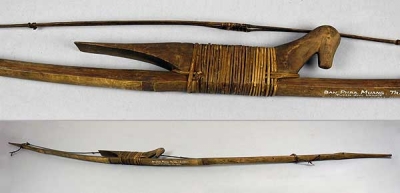Pellet bow (1902.88.64)
 ThailandPellet bow from Thailand, Asia. Collected by Thomas Nelson Annandale on expedition with Herbert Christopher Robinson to the Malay Peninsula between 1901 and 1902. Purchased by the Museum from him in 1902.
ThailandPellet bow from Thailand, Asia. Collected by Thomas Nelson Annandale on expedition with Herbert Christopher Robinson to the Malay Peninsula between 1901 and 1902. Purchased by the Museum from him in 1902.
The pellet bow was a weapon with a diverse distribution around the world. It shot pellets or stones instead of arrows. This example, with a grip carved in the shape of a turtle-dove, was collected along with many other objects by the famous anthropologist Nelson Annandale in May 1902 in the large Thai village of Ban Phra Muang, at the mouth of the Trang River, on the Andaman Sea.
Form and Function
It is easy to view the relationship between archery and firearms as one of technological evolution, of the irresistible replacement of one by the other. However, for many years, these two different technologies existed simultaneously. Thus it is best to think of them as complementary, rather than conflicting, strategies in the overall development of the same ballistic weapons technology. Weapons such as the crossbow and pellet bow illustrate most clearly the development of ideas concerning release mechanisms and projectile types, respectively.
Pellet-bows fire round shot, pellets or 'bullets', which are loaded into a small pouch tied into the middle of the bow-string. They are, basically, extremely large and powerful catapults. This example was produced by the coastal people of Trang (one of Thailand's most southerly provinces), who term themselves Orang Laut Islam ('Muslim Sea Folk'). The people of this region are of mixed Thai and Malay stock, who converted to Islam in the mid-19th century. As the collector, Annandale, later said: "The most characteristic weapon of the [people] of Trang is the pellet bow, which has reached a higher development among them than in any other tribe we saw in the Malay Peninsula."
This particular pellet-bow is constructed from palm-wood, with a string of rattan. The string is split at its mid-point, and has a small basket inserted into it. The shot for such a weapon is a small round ball of dried clay. Such weapons were generally hung over the family fire to blacken and season the wood, and were capable of killing large game, and seriously wounding human beings.
Pellet bows do, however, possess a single major functional flaw. Whereas an arrow is guided past the bow-hand, it is actually relatively easy to shoot yourself in the hand with a pellet-bow. Anyone who has ever owned a catapult will probably relate to this. The Orang Laut bows overcome this by attaching a wooden thumb-guard to the bow, shaped like a bird. These are carved to resemble either a woodpecker or, as is the case here, a turtle-dove.





